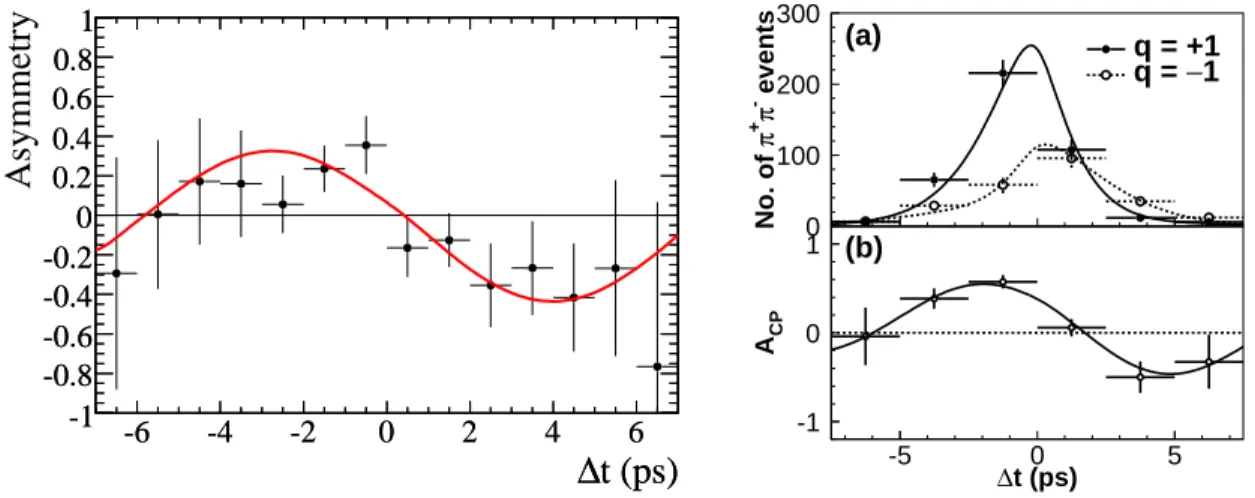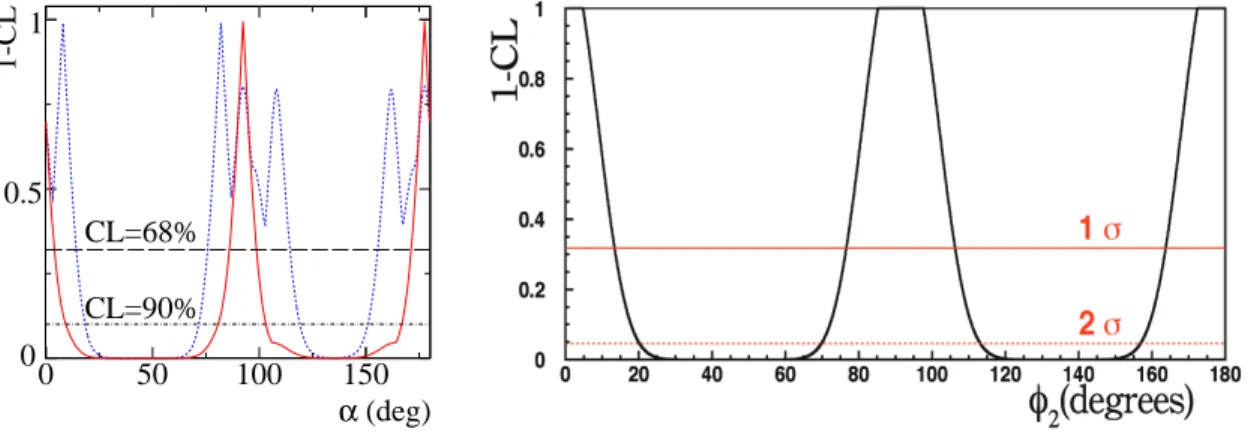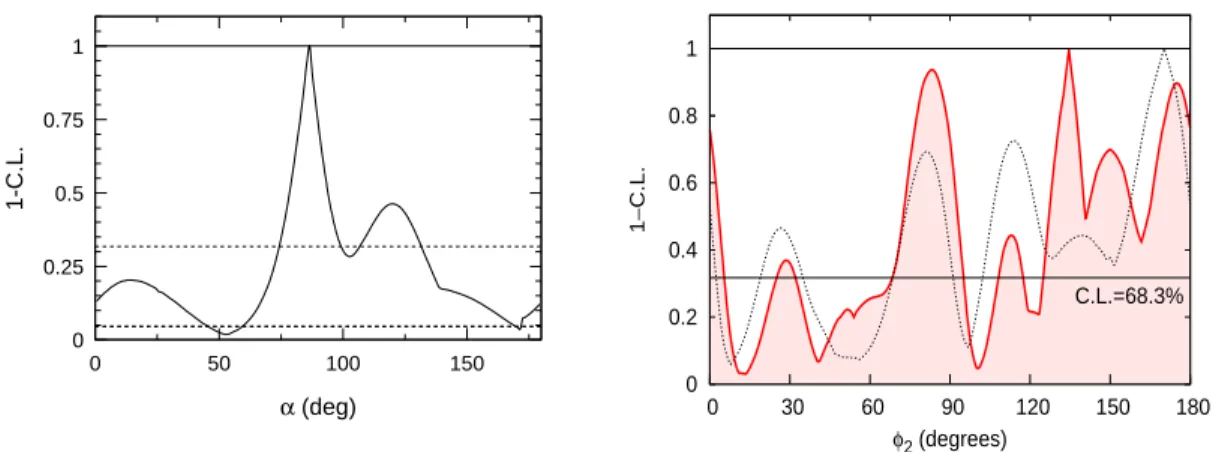arXiv:1101.1720v1 [hep-ex] 10 Jan 2011
Measurement of α/φ 2 in B → ππ, ρπ and ρρ
J. Dalseno
Max-Plank-Insitut f¨ ur Physik F¨ oringer Ring 6 M¨ unchen 80805 GERMANY Technische Universit¨ at M¨ unchen
Excellence Cluster Universe Boltzmannstraße 2 Garching 85748 GERMANY
We present a summary of the measurements of the CKM angle, α (φ 2 ), performed by the BaBar and Belle experiments which collect BB pairs at the Υ(4S) resonance produced in asymmetric e + e − collisions. We discuss the measurements of the branching fractions and CP asymmetries in the B → ππ, ρπ and ρρ final states that lead to constraints on α (φ 2 ).
PRESENTED AT
Proceedings of CKM2010, the 6th International Workshop on the CKM Unitarity Triangle
University of Warwick, UK, 6-10 September 2010
1 Introduction
The main goal of the BaBar experiment at SLAC and the Belle experiment at KEK is to constrain the unitarity triangle for B decays. This allows us to test the Cabibbo- Kobayashi-Maskawa (CKM) mechanism for violation of the combined charge-parity (CP ) symmetry [1, 2], as well as search for new physics effects beyond the Standard Model (SM). These proceedings give a summary of the experimental status of mea- surements of the CKM phase, α, hitherto referred to as φ 2 , defined from CKM matrix elements as φ 2 ≡ arg( − V td V tb ∗ )/(V ud V ub ∗ ).
First-order weak processes (tree) proceeding by b → uud quark transitions such as B 0 → ππ, ρπ, ρρ and a 1 (1260)π, are directly sensitive to φ 2 . In the quasi-two-body approach, CKM angles can be determined by measuring the time-dependent asym- metry between B 0 and B 0 decays [3]. For the decay sequence, Υ(4S) → B CP B Tag → f CP f Tag , where one of the B mesons decays at time, t CP , to a CP eigenstate, f CP , and the other decays at time, t Tag , to a flavour specific final state, f Tag , with q = +1( − 1) for B Tag = B 0 (B 0 ), the decay rate has a time-dependence given by
P (∆t, q) = e −|∆t|/τ
B04τ B
01 + q(A CP cos ∆m d ∆t + S CP sin ∆m d ∆t)
, (1)
where ∆t ≡ t CP − t Tag and ∆m d is the mass difference between the B H and B L
mass eigenstates. The parameters, A CP and S CP , describe direct and mixing-induced CP violation, respectively. An alternate notation where C CP = − A CP also exists in literature.
If a single first-order weak amplitude dominates the decay, then we expect A CP = 0 and S CP = sin 2φ 2 . On the other hand, if second-order loop processes are present, then direct CP violation is possible, A CP 6 = 0. Additionally, as these loop processes (penguins) are not directly proportional to V ub , our measurement of S CP does not directly determine φ 2 , rather, S CP = q 1 − A 2 CP sin(2φ 2 − 2∆φ 2 ), where ∆φ 2 is the shift caused by the second order contributions.
Despite this, it is possible to determine ∆φ 2 in B 0 → h + h − with an SU (2) isospin analysis by considering the set of three B → hh decays where hh is either two pions or two longitudinally polarised ρs [4]. The B → hh amplitudes obey the complex triangle relations,
A +0 = 1
√ 2 A +− + A 00 , A −0 = 1
√ 2 A +− + A 00 . (2) Isospin arguments demonstrate that B + → h + h 0 is a pure first-order mode in the limit of neglecting electroweak penguins, thus these triangles share the same base, A +0 = A −0 , and ∆φ 2 can be determined from the difference between the two triangles.
This method has an inherent 8-fold discrete ambiguity in the determination of φ 2 .
2 B → ππ
The analysis of B → ππ performed by the BaBar collaboration is based on their full data set 467 million BB pairs [5], while the analysis from the Belle collaboration is based on 535 million BB pairs [6]. They obtain the CP parameters,
BaBar Belle
A CP = +0.25 ± 0.08 ± 0.02 (3.0σ) A CP = +0.55 ± 0.08 ± 0.05 (5.5σ) S CP = − 0.68 ± 0.10 ± 0.03 (6.3σ) S CP = − 0.61 ± 0.10 ± 0.04 (5.3σ), and the fit projections are shown in Fig. 1. Both experiments have observed CP violation in B → ππ and the difference between the two measurements is 1.9σ. In the isospin analysis to remove the penguin contribution, BaBar excludes the range [23 ◦ , 67 ◦ ] at the 90% CL and Belle excludes the range [11 ◦ , 79 ◦ ] at the 95% CL.
t (ps)
-6 -4 -2 0 2 4 ∆ 6
Asymmetry
-1 -0.8 -0.6 -0.4 -0.2 0 0.2 0.4 0.6 0.8 1
t (ps)
-6 -4 -2 0 2 4 ∆ 6
-1 -0.8 -0.6 -0.4 -0.2 0 0.2 0.4 0.6 0.8 1
0 100 200 300
q = +1 q = − 1 (a)
No. of π
+π
-events
-1 0 1
-5 0 5
∆t (ps) A
CP(b)
Figure 1: The left plot shows the time-dependent asymmetry, a(∆t) ≡ (N B Tag
0− N Tag
B
0)/(N B Tag
0+ N Tag
B
0), of B 0 → π + π − from BaBar. The right plots from Belle show the fit to ∆t for each flavour tag on top and the resulting asymmetry below. Mixing- induced CP violation can be clearly seen in the asymmetry plots and the height difference in the ∆t projection indicates direct CP violation.
3 B → ρρ
B → ρρ decays have an additional complication that the two spin-1 ρ mesons have
a relative orbital angular momentum, L = 0, 1, 2. Since the CP eigenvalue of B 0 →
ρ + ρ − is ( − 1) L , it is necessary to isolate a definite CP component through angular
analysis in order to constrain φ 2 . Conveniently, it turns out that the ρρ system is
dominated by the CP -even longitudinal amplitude [7, 8], which means the transverse
component can be ignored in the constraint of φ 2 .
The BaBar analysis of B 0 → ρ + ρ − is based on 384 million BB pairs [7] while the Belle analysis is based on 535 million BB pairs [9]. They obtain the CP parameters,
BaBar Belle
A CP = 0.01 ± 0.15 ± 0.06 A CP = +0.16 ± 0.21 ± 0.07 S CP = − 0.17 ± 0.20 +0.05 −0.06 S CP = +0.19 ± 0.30 ± 0.07.
The BaBar collaboration has recently updated their B + → ρ + ρ 0 analysis with their final data set [10]. They obtain the branching fraction, B(B + → ρ + ρ 0 ) = (23.7 ± 1.4 ± 1.4) × 10 −6 , which allows a precise measurement of the isospin triangle base, and A CP = 0.054 ± 0.055 ± 0.010, showing no evidence for amplitudes that do not conserve isospin.
Both collaboration have also presented result on B 0 → ρ 0 ρ 0 . This is mode is experimentally difficult to isolate due to its relatively low branching fraction in the presence of multiple backgrounds with the same final state. BaBar has observed this mode with a significance of 3.1σ [11] and obtained the CP parameters, A CP =
− 0.2 ± 0.8 ± 0.3 and S CP = +0.3 ± 0.7 ± 0.2, while Belle has obtained an upper limit [12].
A consequence of the small B 0 → ρ 0 ρ 0 branching fraction relative to B + → ρ + ρ 0 , is that the isospin triangles become flat making the 4 solutions of ∆φ 2 nearly degenerate. The constraints on φ 2 in B → ρρ are shown in Fig. 2 from which BaBar determines φ 2 = (92.4 +6.0 −6.5 ) ◦ and Belle finds φ 2 = (91.7 ± 14.9) ◦ .
(deg) α
0 50 100 150
1-CL
0 0.5
1
CL=68%
CL=90%
Figure 2: The left plot shows the constraint on φ 2 in the B → ρρ system using only
BaBar results. The right plot shows the constraint from Belle which uses its latest
B 0 → ρ 0 ρ 0 result, otherwise world averages. This analysis was performed before the
recent update of B + → ρ + ρ 0 from BaBar and a plateau is present as there is no
constraint on A CP (ρ 0 ρ 0 ).
α (deg)
1-C.L.
0 0.25 0.5 0.75 1
0 50 100 150
0 0.2 0.4 0.6 0.8 1
0 30 60 90 120 150 180
1−C.L.


